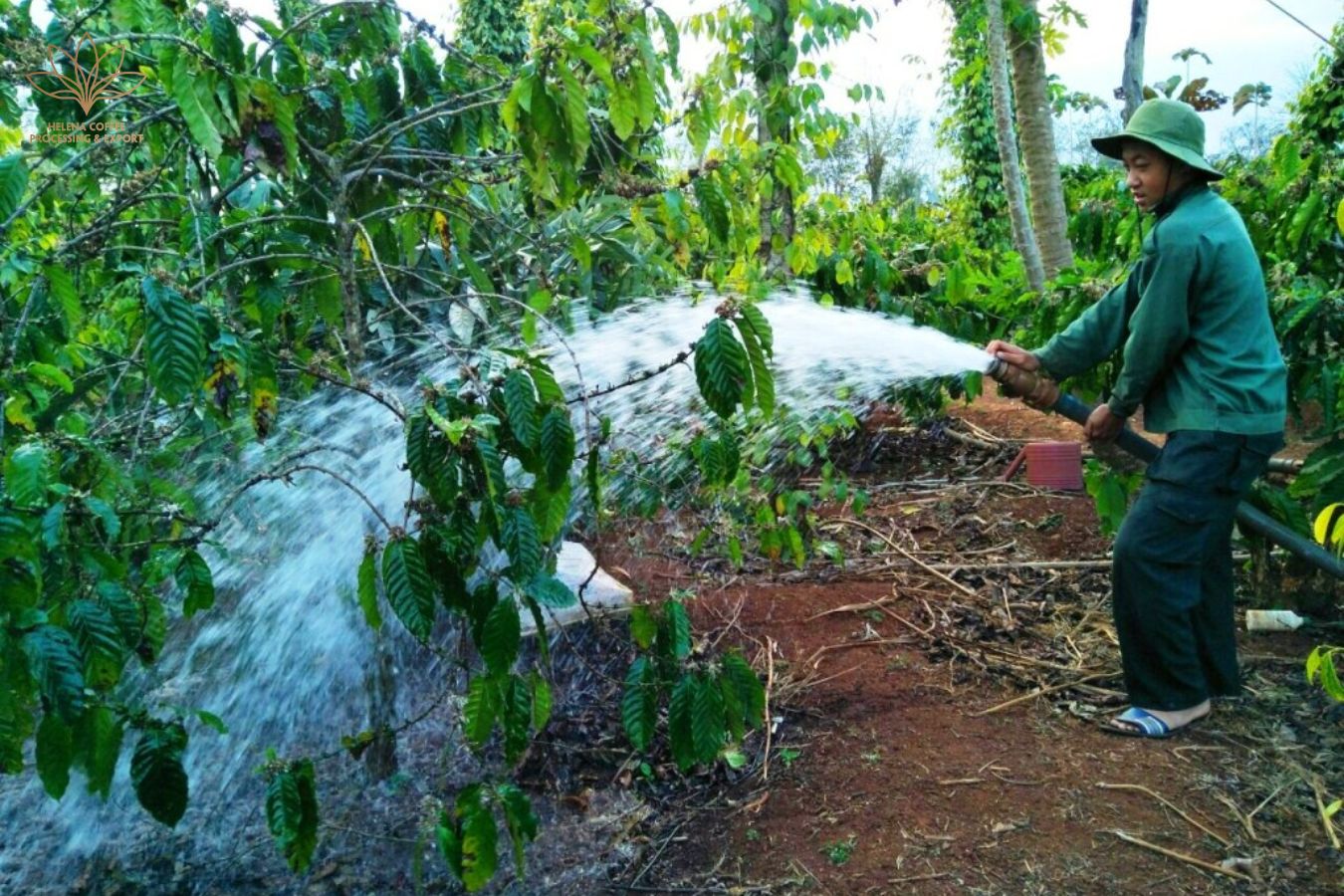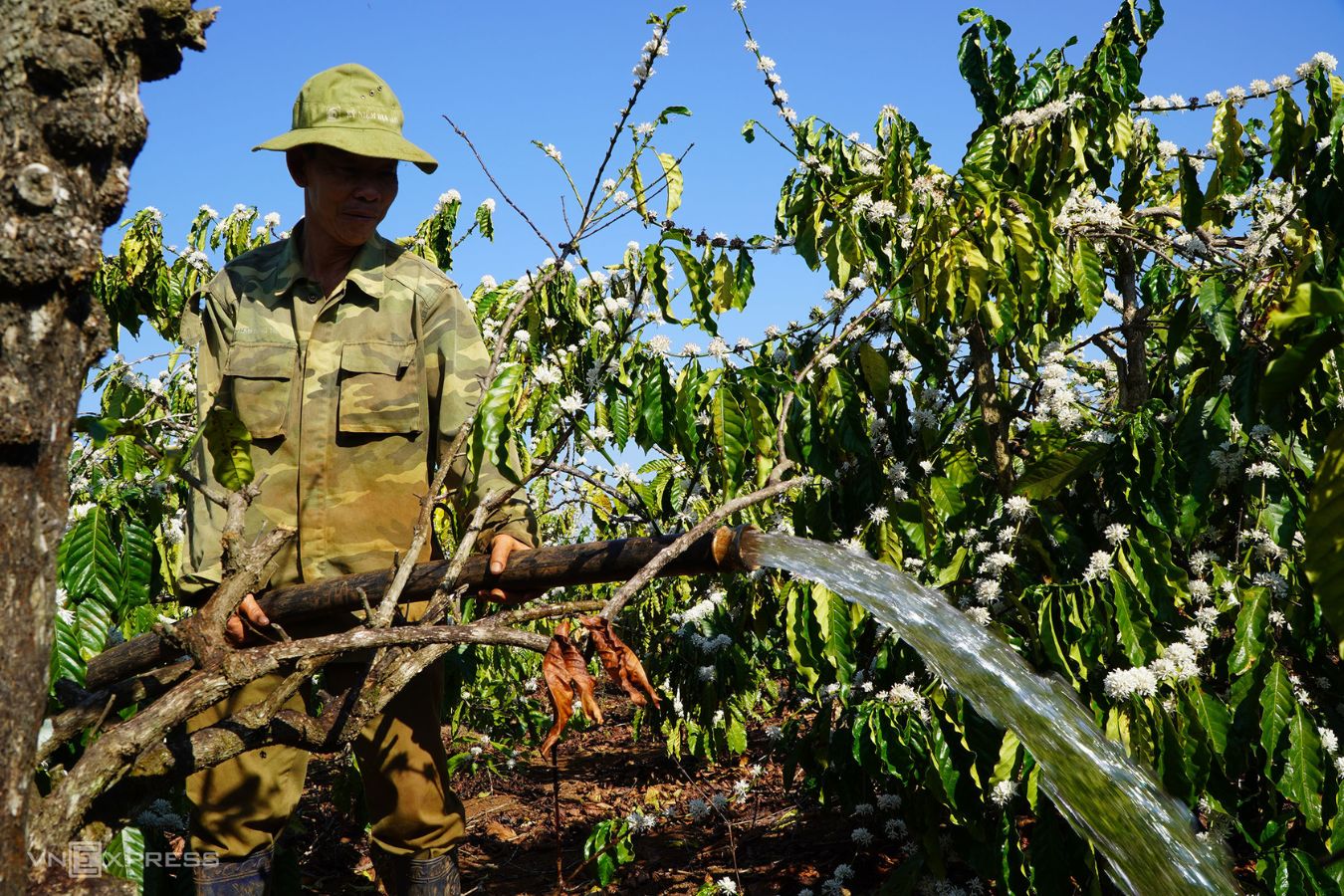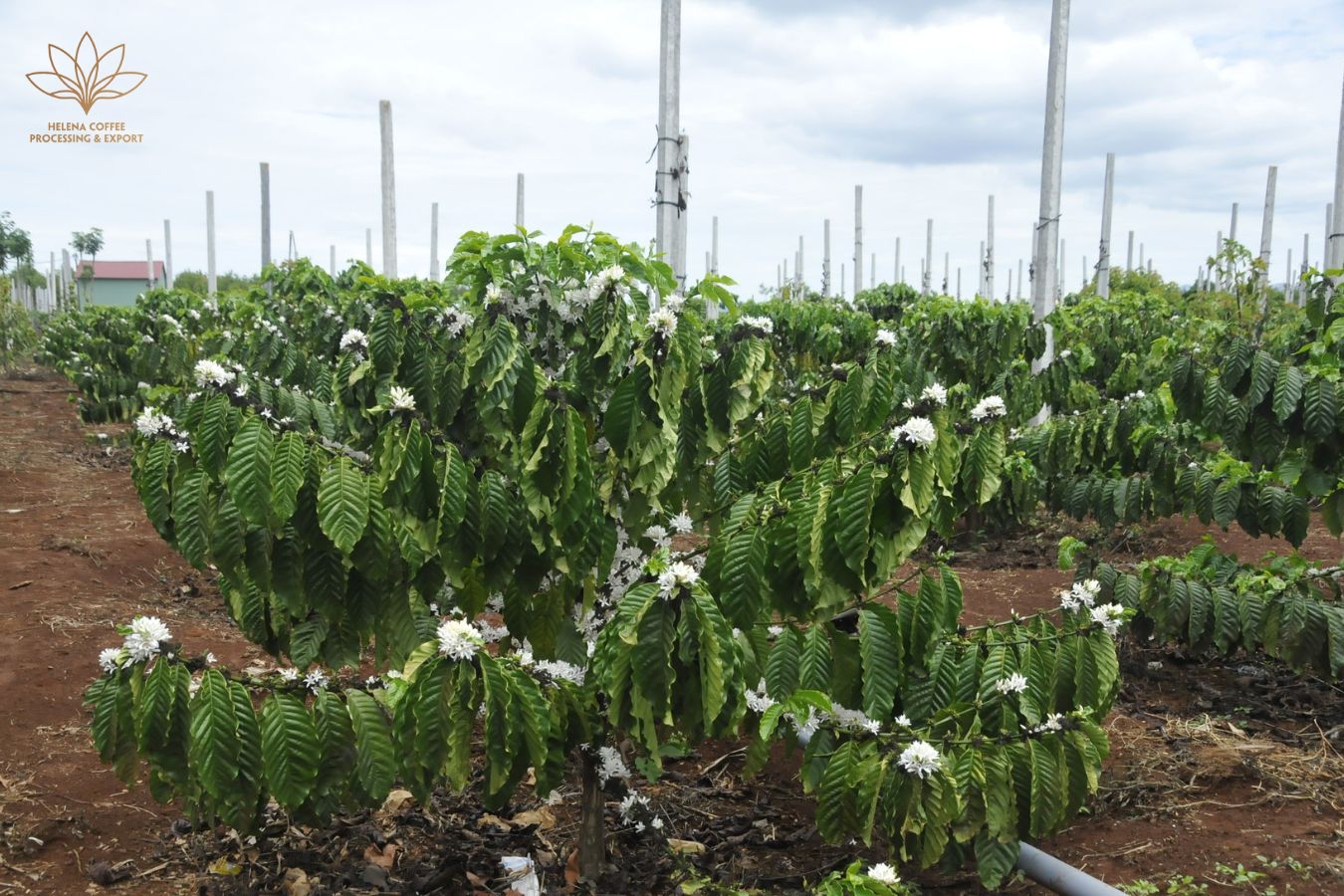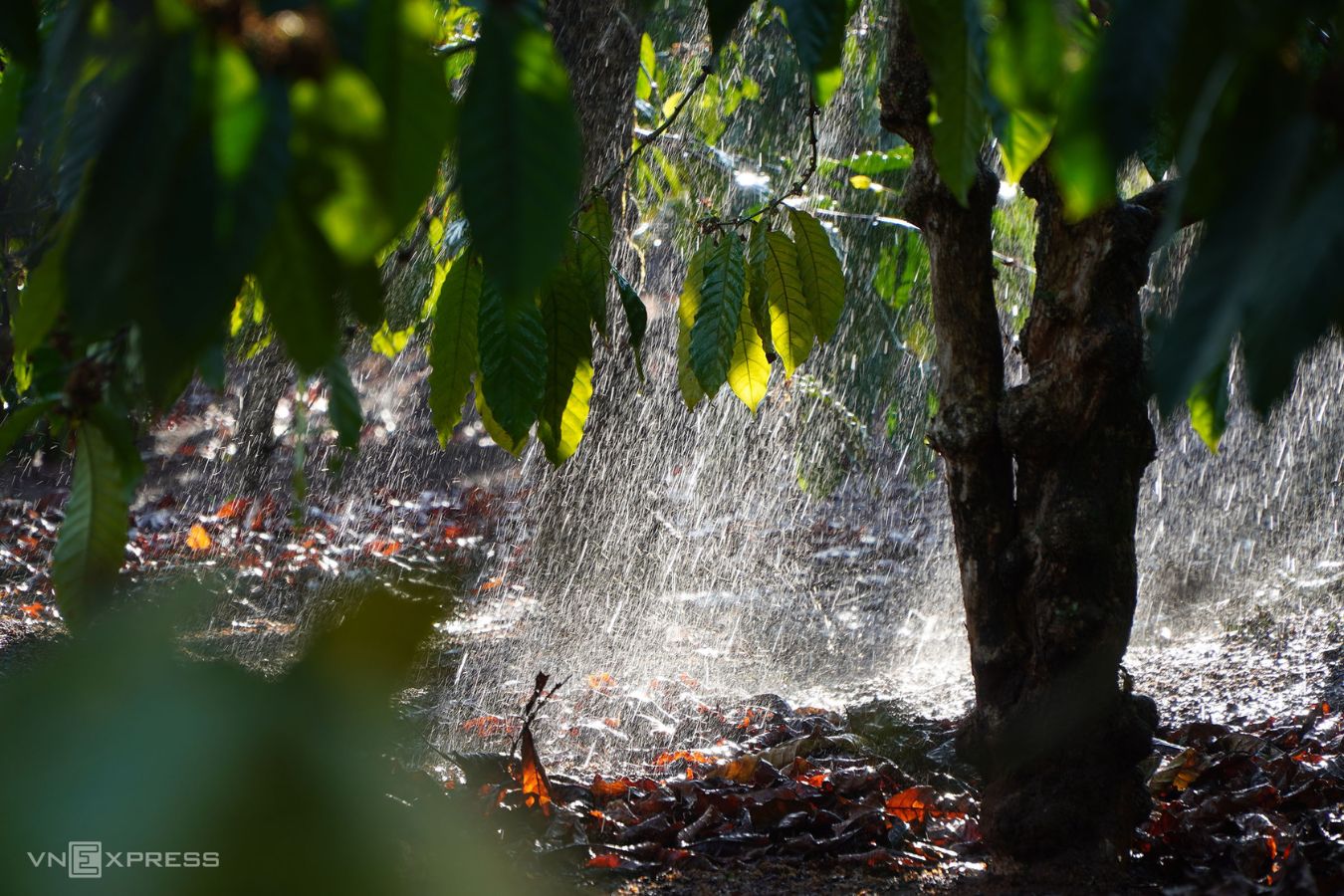
Farming 07: The Role Of Irrigation Water In Coffee Production – Whole Farming is a particular column from Helena Coffee Vietnam that provides an overview of what you can and can’t control, as well as how to exercise what holds you can create a sustainable crop and a good cup of coffee.
Irrigation is the controlled supply of water to plants. Watering helps coffee plants grow healthy and productive during periods of little rain. Still, there are other benefits – controlling flowering time and fruit ripening, potentially protecting the soil (compacting), or preventing weed growth.

Only 10% of the agricultural land used to grow coffee in Brazil is irrigated. However, this 10% provides 22% of the total coffee production yearly (Gleice A. de Assis et al., 2014).
This statistic shows that irrigation has a significant impact on increasing productivity.
Enhancing the water supply and nutrients through irrigation combined with fertilization also allows for a higher density of cultivated crops, increasing yields over the same land area.
However, when applied in practice, there is no one-size-fits-all approach: the ideal amount and irrigation duration depends on local conditions, including latitude, precipitation distribution, timing and severity of the dry season, soil type, and depth.
For robusta, watering helps to produce flowers by 48-57% and if irrigation is maintained during the dry season, the yield will increase by 85-95% compared to non-irrigated areas. – Naidu, 2003
Irrigation needs
Typically, coffee plants have shallow roots, concentrated in the 0-30 cm layer, so the drought tolerance of coffee plants is very low compared to many other perennial plants.
According to WASI’s studies, providing enough water for coffee plants through irrigation doubles the length of horizontal branches due to an increase in the number of burns and burning size, increase in leaf area by 45%, retains leaf sets better than plants that are not watered; improved nutrient absorption; ripe fruits concentrated.
For coffee, watering helps with flowering by 48-57%, and if irrigation is maintained during the dry season, the yield will increase by 85-95% compared to non-irrigated areas (Naidu, 2003).

After pollination, the coffee fruit will go through a “sleep” period lasting about three months; the fruit barely grows in size and weight. After the dormant period, the fruit begins to increase; the plant requires a lot of water and nutrition to feed the fruit.
The fruit development period coincides with the first months of the rainy season with enough water and fertilization, creating favorable conditions for coffee trees to grow well and achieve high yields in the Central Highlands.
In the climatic conditions of the Central Highlands, there is a long and fierce dry season; if there is no additional irrigation in the dry season, the cultivation of coffee will not be effective.
According to Le Ngoc Treasure, in 1978, when the study determined the original cabinet mode and water for coffee, in the conditions of non-watering and having root cabinets, the flowering of coffee plants is entirely dependent on nature, coffee yield is low and unstable, encountering unfavorable conditions such as unseasonal rains in the middle of the dry season stimulates flowers to bloom, All these flowers will be shrunk due to drought the plant may not bear fruit.
Flowering
The period of constant water stress for several months (dry season) is when the plant prepares its buds. This stage can control flowering time by deliberately exposing the plant to drought pressure and watering it. This measure may shorten the harvest period in some areas.
Determining the timing of the first irrigation when the buds have fully differentiated will contribute to the coffee plant’s concentrated bloom.
When the flower sprouts fully develop on the outermost vertebrae of the branches, about 1.5 cm long, are ivory white, and the leaves have begun to wilt during the day, it is time to water.
Usually, the humidity to be irrigated is higher than wilted plants’ moisture. The humidity to be washed at the 0 – 30 cm floor is chosen for basalt soils to be about 27% (BMT Coffee Association, 2021).

Not watering early when the buds are not fully differentiated will cause the flowers to bloom unfocused and the fruits to ripen scattered, increasing costs and wasting water resources.
However, when the plant has symptoms of temporary wilting, drooping leaves during the day, and soil moisture below 27%, the flower buds have not fully differentiated; they must still be watered so that the coffee plant is not damaged.
Late irrigation of plants is depleted, deciduous, dried branches, flowers are shrunk, bloom poorly, and flowers suffer from low yield “lemon blossoms,” affecting the growth and development of plants.
Under natural conditions, hibernation of flower buds is often disrupted by early-season rains after a dry period. – Barros et al., 1999
Fruiting
About six weeks after fruiting, the fruit begins to increase.
This is the stage that determines the final size of the fruit – and also the size of the seed. In countries like Kenya, where the rainy season doesn’t necessarily coincide with a period of fruit bloom, irrigation and mulching (to keep water in the soil) can help increase the size of giant coffee beans.
In a study in Ruiru, Kenya, irrigation was shown to have a negligible effect on overall yields but increased the output of AA and AB bean sizes – more than twice that of coffee plants grown in a dry year (MGR Cannell, 1973).
Stress caused by lack of water also reduces the growth of leaves and branches, reducing bud length and leaf area. The bud growth of Arabica and Robusta coffee plants is slow in the dry season, calm, and fast in the warm, rainy season (DaMatta et al., 1999).
Therefore, water sources instead of temperatures will play a decisive role in the recovery of growth after the containment period due to water shortages.

Plants sometimes do not react to irrigation water as we expect. For example, at high temperatures (> 26°C), the plant closes the pores on the leaves and stops collecting water, even if there is a lot of water in the soil.
In a study in Kenya, increasing crop density did not increase drought-induced stress, suggesting that irrigation is not always necessary for more intensive farming.
Irrigation systems have significant capital costs, which is difficult for many coffee farmers, as do some labor costs.
To set up irrigation systems, farms need a minimum of a reliable source of water, a filtration system, pumps and the means that power them, and a significant amount of equipment, including faucets and sprinklers, as well as a workforce to operate them as needed.
For this reason, many farmers depend on the climate for available water rainfall. Even with an irrigation system, there are some limitations to what it can achieve.
If irrigation timing is not ideal, it may affect the timing of flowering or fruiting or be less effective than when appropriately applied.
(*) Kenyan coffee is classified by bean size, excluding special beans such as Kenya E (Elephant Bean) and Kenya PB (Peaberry). Kenya AA is the largest size, smaller than Kenya AB, C, TT, T, and MH/ML.
References:
- Primecoffea, Canh tác 08: Kỹ thuật tưới nước cho cây cà phê, Tháng Một 19, 2023.